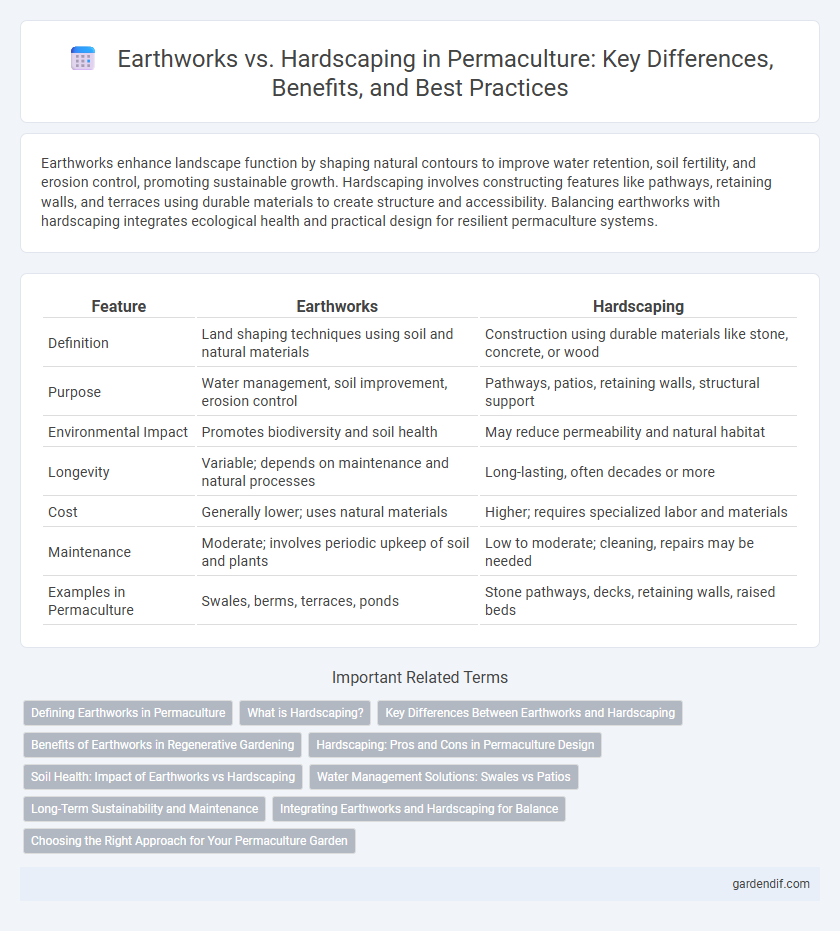
Earthworks vs Hardscaping Illustration
Earthworks enhance landscape function by shaping natural contours to improve water retention, soil fertility, and erosion control, promoting sustainable growth. Hardscaping involves constructing features like pathways, retaining walls, and terraces using durable materials to create structure and accessibility. Balancing earthworks with hardscaping integrates ecological health and practical design for resilient permaculture systems.
Table of Comparison
| Feature | Earthworks | Hardscaping |
|---|---|---|
| Definition | Land shaping techniques using soil and natural materials | Construction using durable materials like stone, concrete, or wood |
| Purpose | Water management, soil improvement, erosion control | Pathways, patios, retaining walls, structural support |
| Environmental Impact | Promotes biodiversity and soil health | May reduce permeability and natural habitat |
| Longevity | Variable; depends on maintenance and natural processes | Long-lasting, often decades or more |
| Cost | Generally lower; uses natural materials | Higher; requires specialized labor and materials |
| Maintenance | Moderate; involves periodic upkeep of soil and plants | Low to moderate; cleaning, repairs may be needed |
| Examples in Permaculture | Swales, berms, terraces, ponds | Stone pathways, decks, retaining walls, raised beds |
Defining Earthworks in Permaculture
Earthworks in permaculture involve the strategic reshaping of land to enhance water retention, soil fertility, and ecosystem health through methods such as swales, terraces, and keyline design. These earth-contouring techniques promote sustainable landscape management by mimicking natural water cycles and reducing erosion. Incorporating earthworks into permaculture systems supports biodiversity and improves microclimates, leading to more productive and resilient agricultural environments.
What is Hardscaping?
Hardscaping in permaculture refers to the design and installation of non-living elements such as pathways, retaining walls, patios, and terraces that enhance the functionality and aesthetics of a garden or landscape. These structures help manage water flow, reduce soil erosion, and create durable spaces for planting and human activity. Integrating hardscaping with earthworks maximizes resource efficiency and promotes sustainable land use.
Key Differences Between Earthworks and Hardscaping
Earthworks in permaculture involve reshaping the land through techniques like swales, berms, and contour trenches to manage water flow and enhance soil fertility, promoting natural ecosystem functions. Hardscaping refers to the installation of permanent, physical structures such as patios, retaining walls, and pathways that provide functional and aesthetic benefits but do not directly support biological processes. The key difference lies in earthworks prioritizing ecological restoration and water management, while hardscaping focuses on durable infrastructure and design elements.
Benefits of Earthworks in Regenerative Gardening
Earthworks in regenerative gardening enhance soil health by improving water retention and reducing erosion, which supports plant resilience and biodiversity. Techniques like swales and berms capture rainwater and promote natural irrigation, decreasing reliance on external water sources. Supporting ecosystem restoration, earthworks foster habitats for beneficial organisms, contributing to long-term sustainability.
Hardscaping: Pros and Cons in Permaculture Design
Hardscaping in permaculture design offers durability and low maintenance by incorporating materials like stone, concrete, and timber to create paths, terraces, and retaining walls. These structures enhance water management, prevent soil erosion, and provide stable infrastructure but can increase initial costs and reduce soil permeability, impacting natural water absorption. Balancing hardscaping with natural elements is essential to maintain ecosystem health and promote biodiversity while optimizing land use efficiency in permaculture systems.
Soil Health: Impact of Earthworks vs Hardscaping
Earthworks such as swales, berms, and keyline designs enhance soil health by promoting water infiltration, reducing erosion, and increasing organic matter retention. Hardscaping, including concrete patios and retaining walls, typically disrupts natural soil processes, leading to compacted soil and decreased microbial activity. Prioritizing earthworks in permaculture practices fosters resilient, fertile soils that support diverse plant and microbial ecosystems.
Water Management Solutions: Swales vs Patios
Swales are earthworks designed to capture and infiltrate rainwater, promoting groundwater recharge and reducing erosion in permaculture landscapes. In contrast, patios are hardscaped surfaces that manage water through runoff control and drainage systems, often directing excess water away from structures. Integrating swales with strategic patio design enhances sustainable water management by combining natural absorption with controlled flow pathways.
Long-Term Sustainability and Maintenance
Earthworks, such as swales and terraces, enhance long-term sustainability by improving soil health, water retention, and ecosystem balance with minimal maintenance once established. Hardscaping elements like stone pathways and retaining walls provide durable structural support but often require regular upkeep to prevent erosion and deterioration. Combining earthworks with strategic hardscaping optimizes permaculture design by balancing natural processes and built infrastructure for resilient landscapes.
Integrating Earthworks and Hardscaping for Balance
Integrating earthworks and hardscaping in permaculture creates a balanced landscape that promotes sustainability and resilience. Earthworks such as swales, berms, and ponds manage water flow and improve soil health, while hardscaping elements like terraces, retaining walls, and pathways provide structural support and accessibility. Combining these techniques enhances ecosystem functionality, reduces erosion, and maximizes resource efficiency in permaculture design.
Choosing the Right Approach for Your Permaculture Garden
Earthworks in permaculture involve reshaping the landscape through swales, berms, and ponds to enhance water retention and soil fertility, creating a self-sustaining ecosystem. Hardscaping uses materials like stone, wood, and concrete to build terraces, paths, and retaining walls, providing structure and durability for garden systems. Selecting the right approach depends on your site's topography, climate, and long-term goals for water management and ecosystem health.
Earthworks vs Hardscaping Infographic

 gardendif.com
gardendif.com